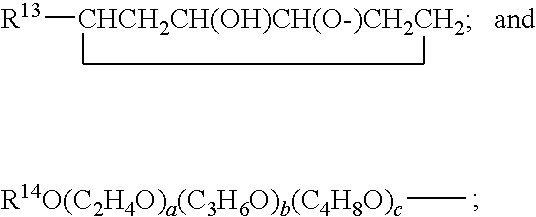Hydrolysis resistant organomodified silylated ionic surfactants
a technology of ionic surfactants and silylated ion, which is applied in the field of silane compositions, can solve the problems of inability to stablely hydrolyze trisiloxane compounds
- Summary
- Abstract
- Description
- Claims
- Application Information
AI Technical Summary
Benefits of technology
Problems solved by technology
Method used
Image
Examples
preparation example 1
[0108]N,N-dimethyl aminopropyl pentamethyl carbodisilane (Figure 1). 16.0 g pentamethyl carbodisilane and 20 μL platinum 1,3-divinyl-1,1,3,3-tetramethyldiloxane complex (0.3 wt % solution in xylene) were charged into 100 mL Schlenk flask. The mixture was heated to 90° C. and 9.35 g N,N-dimethyl allyl amine was added dropwise in 20 min. After addition, the reaction temperature was maintained at 90° C. for 3 hrs and the reaction was monitored by 1HNMR. After removing solvent under vacuum, the mixture was distilled under reduced pressure, and 17.0 g colorless oil was collected at 109-111° C. / 15 mmHg.[0109]Figure 1. Reaction Sequence for Preparation of Amino Silane Intermediate 1.
[0110]
preparation example 2
[0111]3-({3-[Dimethyl-(2-trimethylsilanyl-ethyl)-silanyl]-propyl}-dimethyl-amino)-propane-1-sulfonate (Figure 2). 2.0 g N,N-dimethyl aminopropyl pentamethyl carbodisilane 1 and 1.10 g1,3-propanesultone were dissolved in 15 ml dry THF. The mixture was heated to reflux overnight. After removing solvent, 3.03 g white solid was obtained.[0112]Figure 2. Reaction Sequence for Preparation of Silane 2.
[0113]
preparation example 3
[0114]4-([3-[Dimethyl-(2-trimethylsilanyl-ethyl)-silanyl]-propyl]-dimethyl-amino)-butane-1-sulfonate (Figure 3). 2.45 g N,N-dimethyl aminopropyl pentamethyl carbodisilane 1 and 1.40 g1,4-butanesultone were dissolved in 10 ml dry THF. The mixture was heated to reflux overnight. After removing solvent, 2.94 g white solid was obtained.[0115]Figure 3. Reaction Sequence for Preparation of Silane 3.
[0116]
PUM
| Property | Measurement | Unit |
|---|---|---|
| pH | aaaaa | aaaaa |
| temperature | aaaaa | aaaaa |
| pH | aaaaa | aaaaa |
Abstract
Description
Claims
Application Information
 Login to View More
Login to View More - R&D
- Intellectual Property
- Life Sciences
- Materials
- Tech Scout
- Unparalleled Data Quality
- Higher Quality Content
- 60% Fewer Hallucinations
Browse by: Latest US Patents, China's latest patents, Technical Efficacy Thesaurus, Application Domain, Technology Topic, Popular Technical Reports.
© 2025 PatSnap. All rights reserved.Legal|Privacy policy|Modern Slavery Act Transparency Statement|Sitemap|About US| Contact US: help@patsnap.com



